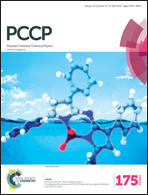Macro and nano scale modelling of water–water interactions at ambient and low temperature: relaxation and residence times
Abstract
The decay dynamics of ambient and low temperature liquid water has been investigated through all-atom molecular dynamics simulations, residence times calculations and time correlation functions from 300 K down to 243 K. Those simulations replicate the experimental value of the self-diffusion constant as a function of temperature by tuning the damping factor of the Langevin equation of motion. A stretched exponential function exp[−(t/τ)β] has been found to properly describe the relaxation of residence times calculated at different temperatures for solvent molecules in a nanodrop of free water modelled as a sphere of nanometric dimensions. As the temperature goes down the decay time τ increases showing a divergence at Ts = 227 ± 3 K. The temperature independence of the dimensionless stretched exponent β = 0.59 ± 0.01 suggests the presence of, not a characteristic relaxation time (since β ≠ 1), but a distribution of decay times that also holds at low temperature. An explanation for such heterogeneity can be found at the nanoscopic level. Moreover it can be concluded that the distribution of times already reported for the dynamics of water surrounding proteins (β ≤ 0.5) can not be exclusively due to the presence of the biomolecule itself since isolated water also exhibits such behaviour. The above reported Ts and β values quantitatively reproduce experimental data.


 Please wait while we load your content...
Please wait while we load your content...